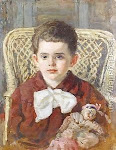
The Old Pretenders
These delightful handcarved 'Queen Anne' style wooden dolls are made by David Chapman & Paul Robins.
English wood dolls of the time are commonly referred to as “Queen Ann” dolls. This may be too general a term as the dolls predate Queen Ann. Eighteen century dolls have different characteristics that can be sorted into three periods:
William and Mary, Queen Ann, and Georgian.













































.jpg)





































































